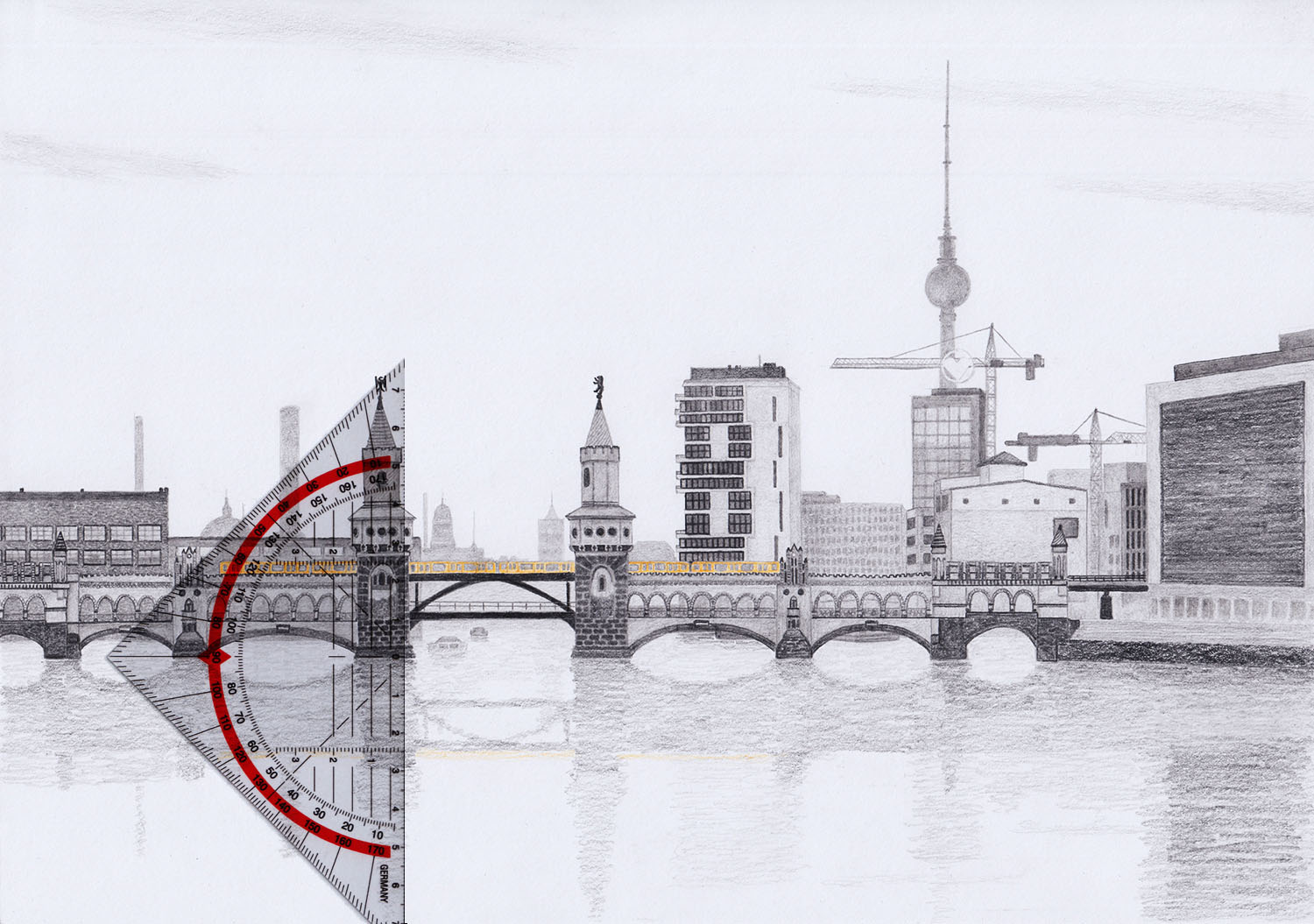In this tutorial, I’ll show you how to draw a city the easy way. The emphasis is on easy because I’m not very good at drawing buildings myself. So I guarantee that if I can do it, you can too!
Drawing the Sketch of a City
It is important for almost every work of art to draw a sketch first. This is also true for the city. Use one or more templates of the city you want to draw for your sketch. This can be photos or you may even be right there and find a comfortable place to draw.
I have great difficulty drawing inorganic structures with straight lines. Thus, I use a regular ruler and a triangle ruler for my sketch. If you have similar problems, try using these tools as well.
Take extra time when sketching and make sure the buildings are all aligned well.

For the buildings in the foreground, draw various details such as windows and doors in the sketch. For the buildings in the background, it is enough to draw only the outlines, as these will fade in the haze.
I draw my hometown Berlin with the Oberbaum Bridge in the foreground and the TV tower in the background. I also add a train of our lovely public transportation called BVG, which will I place right on the bridge.
Drawing the City
Once you are done with the sketch, you can start drawing the city. I chose pencils and a yellow crayon to highlight the BVG train. But, you are welcome to use any other materials if you prefer, such as colored pencils or watercolors.
To make things easy, divide your sketch into three layers with three different shades of gray or color: background, middle ground, and foreground.
It’s best to work our way from light to dark, so let’s start with the background.
Background
In the background in my drawing are the TV tower and a few other buildings. I draw these with the same pencil I used to draw the sketch: a pencil with the hardness F.
The details of the buildings in the background are not well visible. But, you can still hint at them in places so they don’t look too two-dimensional. For example, I added some light and shading to the sphere of my TV tower. On some buildings, I’ve hinted at segments with some darker strokes.

This layer looks quite dark on the blank paper. Once we add the darker layers in the middle and foreground, it will appear light again.
Middle Ground
For the middle ground, I work with two pencils: an F and an HB. For this layer, it’s a good idea to draw details like windows or roofs a little more precisely on two or three buildings. Keep it less precise for the other buildings. This way you still create an illusion of a cityscape without overloading the drawing with details.

I also draw a few boats on the water so that the transition from building to the Spree river doesn’t look so boring.
Foreground
I draw on a sheet of A4 size drawing paper, but to look at the individual areas, we zoom in a little on the drawing.
Drawing clean details becomes more challenging as the paper size gets smaller. But, this isn’t a problem because we can hint at the details instead. Eventually, when viewed as a whole, these hints will have a significant impact, giving the illusion of intricate and complex details. This phenomenon occurs because our brains naturally combine lines, dots, and areas to form recognizable shapes and objects, even if they aren’t fully drawn.

Although I have crossed the Oberbaum Bridge many times, I was never aware of the many details that are on the bridge. And there are quite a lot!
The trick is to simplify the many details. For example, instead of drawing complex patterns, I hint at them with circles or strokes. In other places, I try (if I can) to draw the details more. This alternation of details and hints creates an illusion of many details without having to draw them all.

I decided to only draw the BVG subway in color for my drawing. For this, I use a yellow colored pencil, which contrasts well with the grays of the pencils.
Drawing the Reflection of the City on Water
If there is no water in your drawing of the city, feel free to skip this part.
It is not difficult to draw the reflection of the buildings on the water. All you have to do is draw each building mirrored on the water. But, you only indicate them with wavy lines.
Make sure that the reflection starts where the building or object is next to the water. We can’t just draw a line somewhere and mirror everything there, because that wouldn’t look realistic.

I use a triangle ruler for the reflection. If you move the zero to where the object meets the water, you read the length of one side and transfer it to the other.

Drawing the Sky above the City
Currently, the drawing looks unbalanced. All the buildings are in the middle and the reflections on the water added extra weight to the lower area. A sky is missing, because without it the drawing doesn’t look finished.
I decide to draw a few elongated clouds because they are already enough to create a balance. At the same time, they do not overload the drawing.
